Ireland’s grass-based system produces some of the finest beef in the world – but imagine all of the flavour being built up, over the years, in an older cow.
In Spain’s Galician and Basque regions, some cows live for well over a decade before being retired, finished and slaughtered to become Galician or Basque beef (otherwise known as vaca vieja). Translated into “old cow”, this is considered by many to be some of the best beef in the world.
In recent years, retired dairy cow, “vintage” or even “antique” beef has risen in popularity internationally.
In the US, high-end chefs and small-scale beef farmers have joined forces to serve older dairy cow on restaurant menus. In Britain, retired dairy meat is increasingly seen in specialised butcher shops. Where once this type of beef would only be considered for mince or pet food, it is now beginning to be respected for its fuller flavour profile.
What is it?
Although there is no formal legal definition, retired dairy cow meat can come from animals from
(roughly) five to 11 years old. The process requires the cows to have a “retirement” of several months on grass or finishing feed before being slaughtered. Older cows have distinctive yellow fat, a rich beef flavour and, when aged correctly, produce great prime cuts.
Old assumptions
The general assumption has always been that a cow which has been milked for years and is older than our standard (30-month-old) prime beef will be tough. As a result, older dairy cows, once culled, are considered far less valuable.
Joe Burke, beef and livestock sector manager at Bord Bia, says most culled dairy cows end up in manufacturing channels for export to markets like France and Sweden.
“That being said, where cull cows – especially young cows – are better-finished and therefore achieve a somewhat-improved level of fat cover [three or better], conformation [O- or better] and a carcase weight of say over 300kg, they tend to be much more saleable because more of the carcase [steak cuts] becomes suitable for selling into the food service channel,” he adds. “In some markets, such as France and the north of Spain, chefs and consumers actually have a preference for beef coming from cows [as opposed to prime cattle] on account of its rich flavour profile.”
While older cow meat isn’t as tender as a younger animal, it can still produce some great-quality steaks which are far more developed in flavour. This is the opinion of several Irish chefs who have recently had retired dairy cow on their menus.
The chefs
In 2022, Jess Murphy (of Kai Restaurant in Galway) started using ex-dairy beef. She arranged for five Friesian Holstein cows, which were sourced from the same farm, to be processed for herself and several other chefs. The cows were killed and processed at Brady’s Butcher Shop and Abattoir in Athenry, Co Galway.
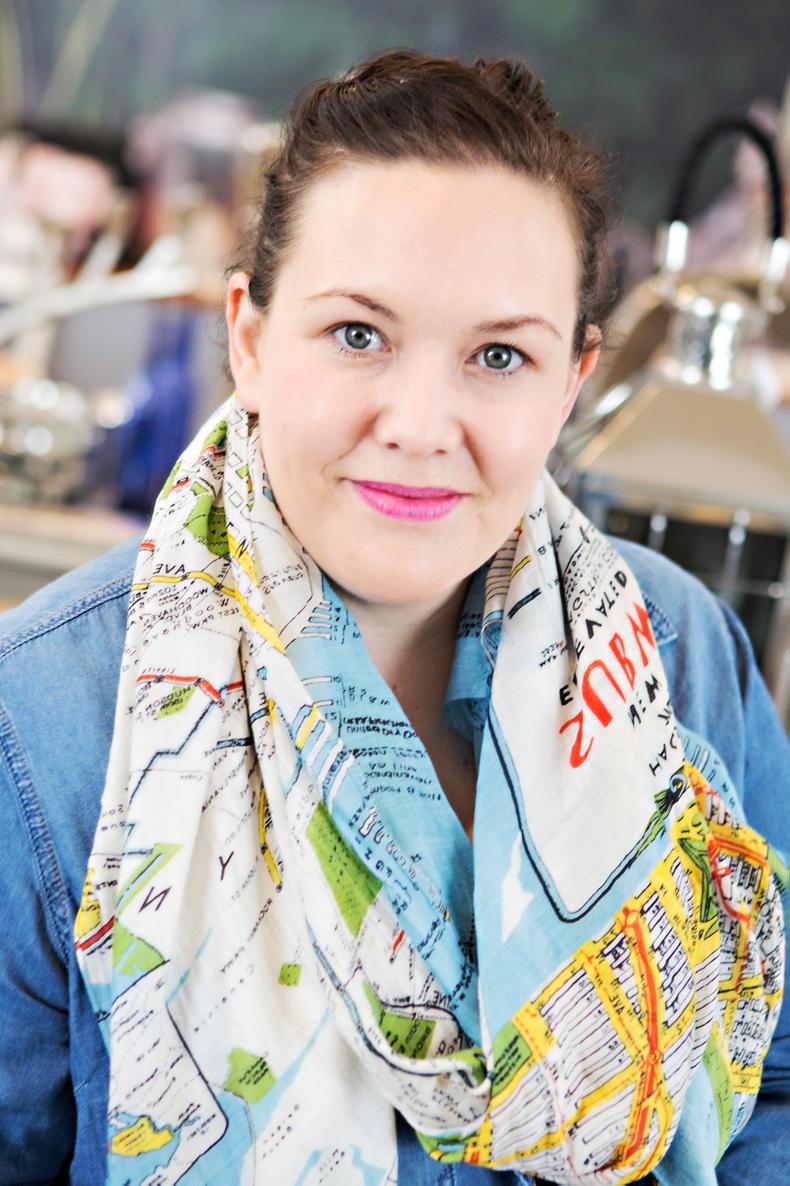
Jess Murphy of Kai Restaurant in Galway. / Martina Regan
“For me, working with retired dairy cow meat was a two-fold thing,” she explains. “First of all, older cow meat is popular in other European countries – so why not here? When it comes to beef, chefs want good-quality fat and [I feel] restaurants in general are becoming less traditional. Lesser-known cuts of meat are being used in all sorts of delicious ways. This could be a good way for farmers to increase profit while potentially bringing down herd numbers.”
The five cows were divided among four high-end restaurants around the country: Kai, Loam (Galway), Aimsir (Kildare) and Library Street (Dublin).
Executive chef of Library Street, Kevin Burke, says he was excited about the opportunity to work with a different ingredient.
“I got a whole forequarter – transporting it [to Dublin] was a whole thing, but it was so much more interesting getting it this way. The farm, the abattoir, the story – the whole idea is what made me want to get it,” he explains.
Kevin admits he doesn’t often use beef and was sceptical regarding the quality and flavour of ex-dairy cow, but was delighted with the outcome. He says more chefs would likely use retired dairy beef on their menus if the logistics (availability and supply) were provided.
“I had a friend who is a butcher help me break it down; I served, mainly, the côte de beouf,” he says. “The flavour was amazing. It wasn’t too funky; just an incredible flavour of beef, but with the right amount of chew. The fat was golden – I haven’t had anything like that in a long time. Our customers – most of them – loved it while a few were put off. I find people love it when they know what it’s about.”
Jersey cow meat
At Overends Kitchen, which is located at Airfield Estate in Dublin, they retire their Jersey milking cows and then serve them in the restaurant as part of their sustainability goals.
Chef Isobel Farrelly says Jersey cows are not built the same as other breeds and she felt to get the best from their meat it required slow cooking.
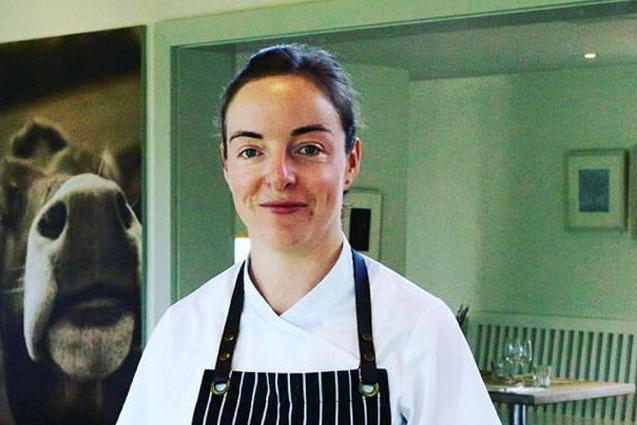
Chef Isobel Farrelly.
“I felt the Jersey steaks weren’t fatty enough, but the meat was perfect for slow-cooking,” she explains.
“So we slow cook the beef for 24 hours in a really low oven before making them into burgers. Steak wouldn’t have shown this product in its best light. We do casual lunches here and burgers are popular with our customers, so it just made perfect sense.
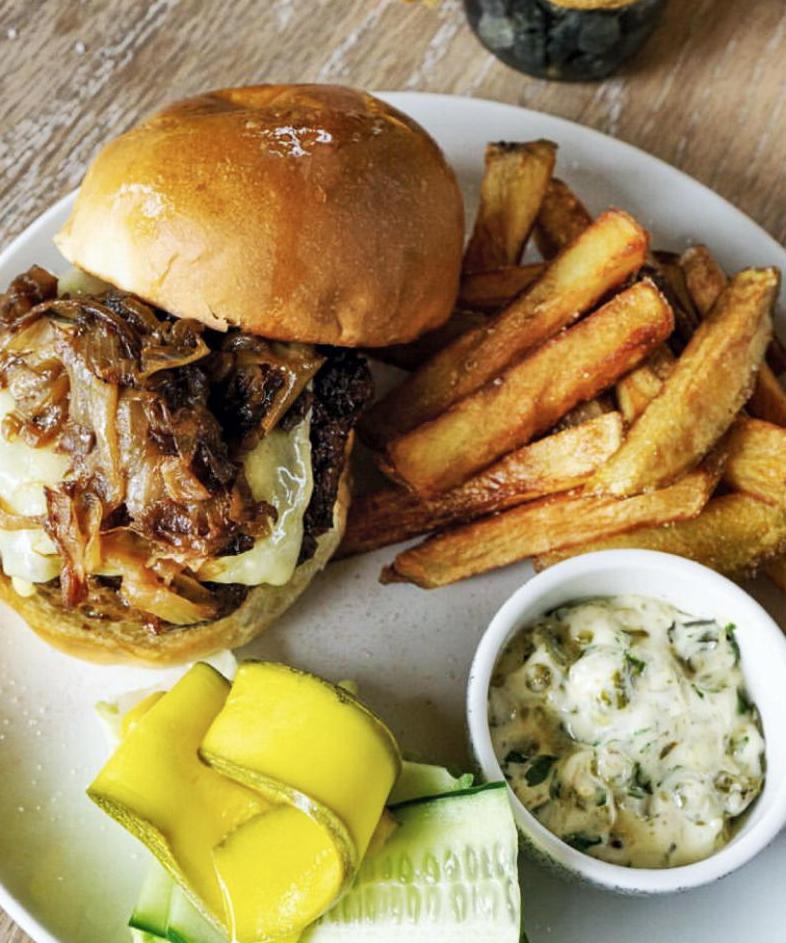
This is a slow cooked Jersey burger from Overends Kitchen
”
Sarah kelly
The Village Butcher Ranelagh are based in Dublin, but offer nationwide delivery on their speciality meat – including retired dairy beef, which they age in their salt chamber for five to six weeks.
“Customers [would be] coming in talking about being in Spain and having the Galician beef, and asking could I get it, would I get it? And my thing always is – why on earth would I be bringing in beef from outside of Ireland? So [instead of bringing in Spanish beef] we sourced some retired dairy cow from Ireland,” explains co-owner Sarah Kelly.
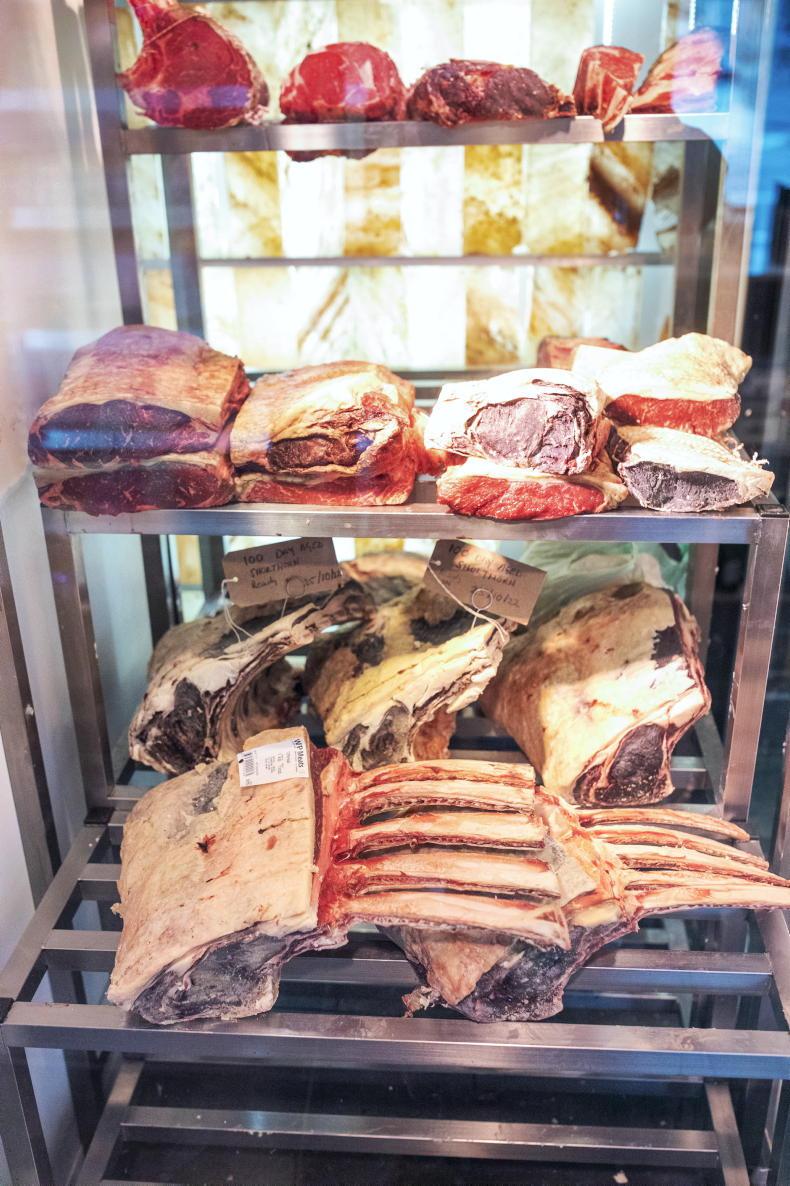
\ Claire Nash
“We got it in and the customers just absolutely loved it; they raved about it to the point now where I have a waiting list.”
At the time of our visit, (autumn, 2022) Sarah was ageing an eight-and-a-half-year-old Friesian dairy cow. As most of its cuts were pre-ordered, the majority had already been sold.
“This is my third [dairy cow]; it might be only every two to three months that I’m able to source one, so this is my third one since maybe March,” she explains. “I’m selling it for just slightly dearer. The ribeyes are selling at €45/kg and the T-bones probably about €35/kg. Which is only a couple of euros more [than an average steak], but I’m only paying a couple of euros more [at the moment].”
The only issue Sarah sees around processing retired dairy beef is the extra paperwork and separate facilities required to butcher older animals – this has put some abattoirs off processing older cows. This is a residual issue from the BSE crisis in the 1990s.

Sarah Kelly. \ Claire Nash
“The abattoir looks after most of that so they’re breaking it down there. I can’t break it down on site here, that would involve a special licence,” Sarah explains. “He breaks it down and I take it broken into the sub-primal cuts and I hang it here. Honestly, in terms of traceability we’re probably the best in the world. We’re definitely much stricter even than in other parts of Europe.”
Darren Flynn
Sarah sources her dairy beef from Darren Flynn in Co Waterford, who is a sixth-generation butcher. He finishes beef on his family farm and has his own abattoir, boning facility and butcher shop.
“What’s very important with [retired dairy cows] is they need to have a rest period from when they’re finished milking on a beef finishing programme. This way, they’re allowed time to rest and develop new muscle. This is one of the most important steps. To fatten those animals, you need to give them the time to convert food into muscle, instead of milk,” he explains.
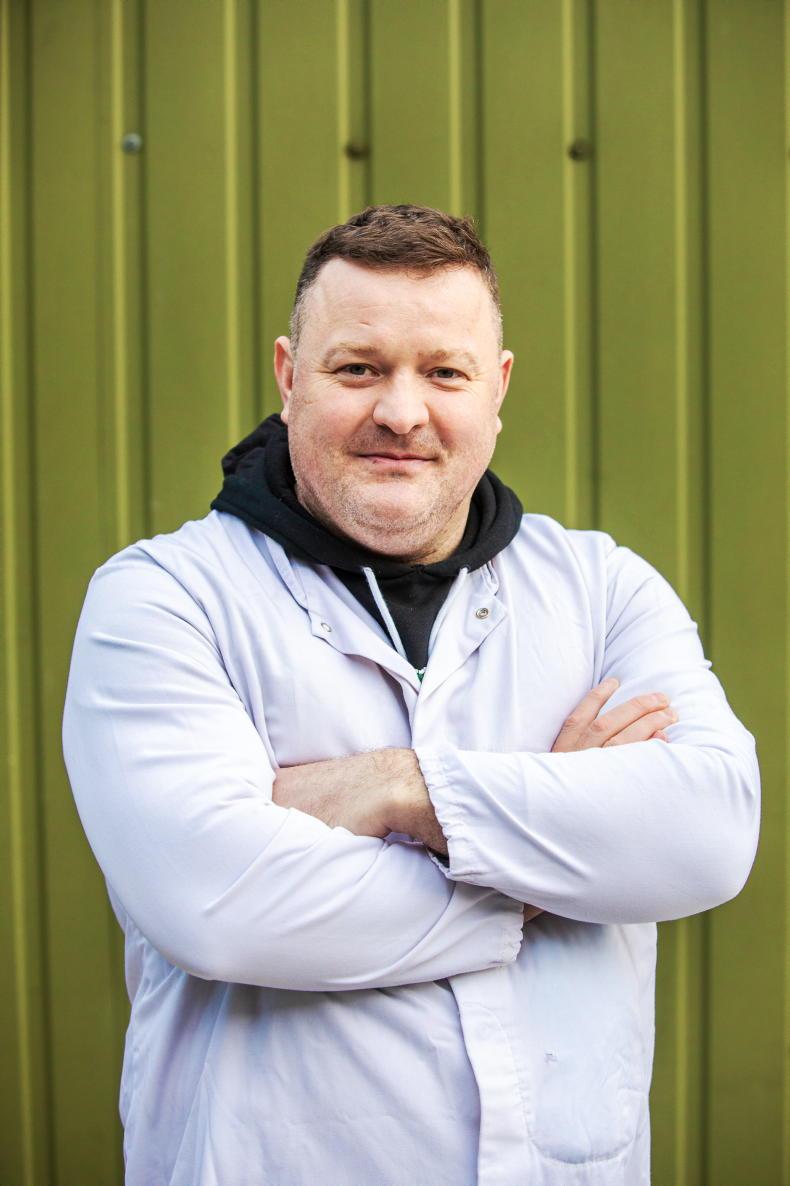
Darren Flynn is a sixth generation butcher from Co Waterford. He sources ex-dairy beef for The Village Butcher in Ranelagh \ Claire Nash
“When the first batch were ready for slaughter, we left them to hang for nearly 30 days, de-boned it, then Sarah took up hers for dry ageing. My understanding is that the time the animal comes to the farm for finishing gives it that time to relax, and then the other important part is you give it two to three times longer to age, for the muscle to break down.”
Darren believes that with our climate and grass-based system, we are in a good position to produce both retired dairy and prime beef for home and export markets.
“Years ago, there were certain cuts on the animal no one wanted,” he says. “As we got more affluent, people wanted fillet steak and the like. But now, cuts like beef cheek and skirt steaks are making a return.”
Irish Country Living asks Darren whether he had tried some ex-dairy beef and, if so, what he thought of the flavour.
“No,” he laughs. “I haven’t tried it yet. I’m a prime beef man, myself.”
Des continues, saying the “nonsense” about the alleged inferiority of dairy beef has now been completely exposed and dairy beef is now not just being sold on grounds of its more competitive price, but also on grounds of better taste and quality. He says this new reality must be reflected in Ireland’s PGI application, where ICMSA wants the inclusion of dairy cow beef up to 120 months that achieved better than O- in grade and with a fat score of 2+ to 5.
Chairperson of the Irish Creamery Milk Suppliers Association, Des Morrison, says grass-fed dairy cow beef, matured naturally - at its own pace - is a superb product and it is gratifying to see Irish chefs, butchers and consumers finally realising what outlets and customers in Spain, Italy and France have always known: that dairy beef is no less excellent than other beef and that the distinction made in Ireland - certainly in terms of price paid by factories - is arbitrary and was never borne from fact.
“ICMSA has maintained for years that there was a bias against dairy beef and that this bias was built into the grid,” he says. “The idea that this bias was justified on grounds of quality is now exposed for the nonsense it always was by the surge in recommendations from chefs and specialist artisan butchers for dairy beef.
“The plain truth is that the factories fully grasped the fact that most cows achieve an O or P and so rather than lifting the prices paid for those grades, they came up with the idea of a steep pyramid that had the best prices paid for E grades,” he continues. “[Of which] only 2% of the cattle coming in were achieving. That sleight of hand on the part of the factories - or con, to be blunt - was so successful that even farmers who would have benefited [from reforms proposed by ICMSA] were convinced to defend the grid and maintain the fiction that dairy beef was in any way inferior.”
“We must build on the new reality which is that retailers, consumers, and farmers have now recognised a parity of quality and taste between dairy and other beef," he states. "And that must be reflected in our marketing and certainly in the payment system operated by the factories. For over a decade we have seen this lop-sided and illogical price-bias, even as demand for dairy beef surged amongst consumers, catering, and hospitality outlets."
Read more
This woman is telling the story of Co Sligo... through shellfish
This Co Sligo farmer practices planned holistic grazing - but what is it?
Ireland’s grass-based system produces some of the finest beef in the world – but imagine all of the flavour being built up, over the years, in an older cow.
In Spain’s Galician and Basque regions, some cows live for well over a decade before being retired, finished and slaughtered to become Galician or Basque beef (otherwise known as vaca vieja). Translated into “old cow”, this is considered by many to be some of the best beef in the world.
In recent years, retired dairy cow, “vintage” or even “antique” beef has risen in popularity internationally.
In the US, high-end chefs and small-scale beef farmers have joined forces to serve older dairy cow on restaurant menus. In Britain, retired dairy meat is increasingly seen in specialised butcher shops. Where once this type of beef would only be considered for mince or pet food, it is now beginning to be respected for its fuller flavour profile.
What is it?
Although there is no formal legal definition, retired dairy cow meat can come from animals from
(roughly) five to 11 years old. The process requires the cows to have a “retirement” of several months on grass or finishing feed before being slaughtered. Older cows have distinctive yellow fat, a rich beef flavour and, when aged correctly, produce great prime cuts.
Old assumptions
The general assumption has always been that a cow which has been milked for years and is older than our standard (30-month-old) prime beef will be tough. As a result, older dairy cows, once culled, are considered far less valuable.
Joe Burke, beef and livestock sector manager at Bord Bia, says most culled dairy cows end up in manufacturing channels for export to markets like France and Sweden.
“That being said, where cull cows – especially young cows – are better-finished and therefore achieve a somewhat-improved level of fat cover [three or better], conformation [O- or better] and a carcase weight of say over 300kg, they tend to be much more saleable because more of the carcase [steak cuts] becomes suitable for selling into the food service channel,” he adds. “In some markets, such as France and the north of Spain, chefs and consumers actually have a preference for beef coming from cows [as opposed to prime cattle] on account of its rich flavour profile.”
While older cow meat isn’t as tender as a younger animal, it can still produce some great-quality steaks which are far more developed in flavour. This is the opinion of several Irish chefs who have recently had retired dairy cow on their menus.
The chefs
In 2022, Jess Murphy (of Kai Restaurant in Galway) started using ex-dairy beef. She arranged for five Friesian Holstein cows, which were sourced from the same farm, to be processed for herself and several other chefs. The cows were killed and processed at Brady’s Butcher Shop and Abattoir in Athenry, Co Galway.

Jess Murphy of Kai Restaurant in Galway. / Martina Regan
“For me, working with retired dairy cow meat was a two-fold thing,” she explains. “First of all, older cow meat is popular in other European countries – so why not here? When it comes to beef, chefs want good-quality fat and [I feel] restaurants in general are becoming less traditional. Lesser-known cuts of meat are being used in all sorts of delicious ways. This could be a good way for farmers to increase profit while potentially bringing down herd numbers.”
The five cows were divided among four high-end restaurants around the country: Kai, Loam (Galway), Aimsir (Kildare) and Library Street (Dublin).
Executive chef of Library Street, Kevin Burke, says he was excited about the opportunity to work with a different ingredient.
“I got a whole forequarter – transporting it [to Dublin] was a whole thing, but it was so much more interesting getting it this way. The farm, the abattoir, the story – the whole idea is what made me want to get it,” he explains.
Kevin admits he doesn’t often use beef and was sceptical regarding the quality and flavour of ex-dairy cow, but was delighted with the outcome. He says more chefs would likely use retired dairy beef on their menus if the logistics (availability and supply) were provided.
“I had a friend who is a butcher help me break it down; I served, mainly, the côte de beouf,” he says. “The flavour was amazing. It wasn’t too funky; just an incredible flavour of beef, but with the right amount of chew. The fat was golden – I haven’t had anything like that in a long time. Our customers – most of them – loved it while a few were put off. I find people love it when they know what it’s about.”
Jersey cow meat
At Overends Kitchen, which is located at Airfield Estate in Dublin, they retire their Jersey milking cows and then serve them in the restaurant as part of their sustainability goals.
Chef Isobel Farrelly says Jersey cows are not built the same as other breeds and she felt to get the best from their meat it required slow cooking.

Chef Isobel Farrelly.
“I felt the Jersey steaks weren’t fatty enough, but the meat was perfect for slow-cooking,” she explains.
“So we slow cook the beef for 24 hours in a really low oven before making them into burgers. Steak wouldn’t have shown this product in its best light. We do casual lunches here and burgers are popular with our customers, so it just made perfect sense.

This is a slow cooked Jersey burger from Overends Kitchen
”
Sarah kelly
The Village Butcher Ranelagh are based in Dublin, but offer nationwide delivery on their speciality meat – including retired dairy beef, which they age in their salt chamber for five to six weeks.
“Customers [would be] coming in talking about being in Spain and having the Galician beef, and asking could I get it, would I get it? And my thing always is – why on earth would I be bringing in beef from outside of Ireland? So [instead of bringing in Spanish beef] we sourced some retired dairy cow from Ireland,” explains co-owner Sarah Kelly.

\ Claire Nash
“We got it in and the customers just absolutely loved it; they raved about it to the point now where I have a waiting list.”
At the time of our visit, (autumn, 2022) Sarah was ageing an eight-and-a-half-year-old Friesian dairy cow. As most of its cuts were pre-ordered, the majority had already been sold.
“This is my third [dairy cow]; it might be only every two to three months that I’m able to source one, so this is my third one since maybe March,” she explains. “I’m selling it for just slightly dearer. The ribeyes are selling at €45/kg and the T-bones probably about €35/kg. Which is only a couple of euros more [than an average steak], but I’m only paying a couple of euros more [at the moment].”
The only issue Sarah sees around processing retired dairy beef is the extra paperwork and separate facilities required to butcher older animals – this has put some abattoirs off processing older cows. This is a residual issue from the BSE crisis in the 1990s.

Sarah Kelly. \ Claire Nash
“The abattoir looks after most of that so they’re breaking it down there. I can’t break it down on site here, that would involve a special licence,” Sarah explains. “He breaks it down and I take it broken into the sub-primal cuts and I hang it here. Honestly, in terms of traceability we’re probably the best in the world. We’re definitely much stricter even than in other parts of Europe.”
Darren Flynn
Sarah sources her dairy beef from Darren Flynn in Co Waterford, who is a sixth-generation butcher. He finishes beef on his family farm and has his own abattoir, boning facility and butcher shop.
“What’s very important with [retired dairy cows] is they need to have a rest period from when they’re finished milking on a beef finishing programme. This way, they’re allowed time to rest and develop new muscle. This is one of the most important steps. To fatten those animals, you need to give them the time to convert food into muscle, instead of milk,” he explains.

Darren Flynn is a sixth generation butcher from Co Waterford. He sources ex-dairy beef for The Village Butcher in Ranelagh \ Claire Nash
“When the first batch were ready for slaughter, we left them to hang for nearly 30 days, de-boned it, then Sarah took up hers for dry ageing. My understanding is that the time the animal comes to the farm for finishing gives it that time to relax, and then the other important part is you give it two to three times longer to age, for the muscle to break down.”
Darren believes that with our climate and grass-based system, we are in a good position to produce both retired dairy and prime beef for home and export markets.
“Years ago, there were certain cuts on the animal no one wanted,” he says. “As we got more affluent, people wanted fillet steak and the like. But now, cuts like beef cheek and skirt steaks are making a return.”
Irish Country Living asks Darren whether he had tried some ex-dairy beef and, if so, what he thought of the flavour.
“No,” he laughs. “I haven’t tried it yet. I’m a prime beef man, myself.”
Des continues, saying the “nonsense” about the alleged inferiority of dairy beef has now been completely exposed and dairy beef is now not just being sold on grounds of its more competitive price, but also on grounds of better taste and quality. He says this new reality must be reflected in Ireland’s PGI application, where ICMSA wants the inclusion of dairy cow beef up to 120 months that achieved better than O- in grade and with a fat score of 2+ to 5.
Chairperson of the Irish Creamery Milk Suppliers Association, Des Morrison, says grass-fed dairy cow beef, matured naturally - at its own pace - is a superb product and it is gratifying to see Irish chefs, butchers and consumers finally realising what outlets and customers in Spain, Italy and France have always known: that dairy beef is no less excellent than other beef and that the distinction made in Ireland - certainly in terms of price paid by factories - is arbitrary and was never borne from fact.
“ICMSA has maintained for years that there was a bias against dairy beef and that this bias was built into the grid,” he says. “The idea that this bias was justified on grounds of quality is now exposed for the nonsense it always was by the surge in recommendations from chefs and specialist artisan butchers for dairy beef.
“The plain truth is that the factories fully grasped the fact that most cows achieve an O or P and so rather than lifting the prices paid for those grades, they came up with the idea of a steep pyramid that had the best prices paid for E grades,” he continues. “[Of which] only 2% of the cattle coming in were achieving. That sleight of hand on the part of the factories - or con, to be blunt - was so successful that even farmers who would have benefited [from reforms proposed by ICMSA] were convinced to defend the grid and maintain the fiction that dairy beef was in any way inferior.”
“We must build on the new reality which is that retailers, consumers, and farmers have now recognised a parity of quality and taste between dairy and other beef," he states. "And that must be reflected in our marketing and certainly in the payment system operated by the factories. For over a decade we have seen this lop-sided and illogical price-bias, even as demand for dairy beef surged amongst consumers, catering, and hospitality outlets."
Read more
This woman is telling the story of Co Sligo... through shellfish
This Co Sligo farmer practices planned holistic grazing - but what is it?













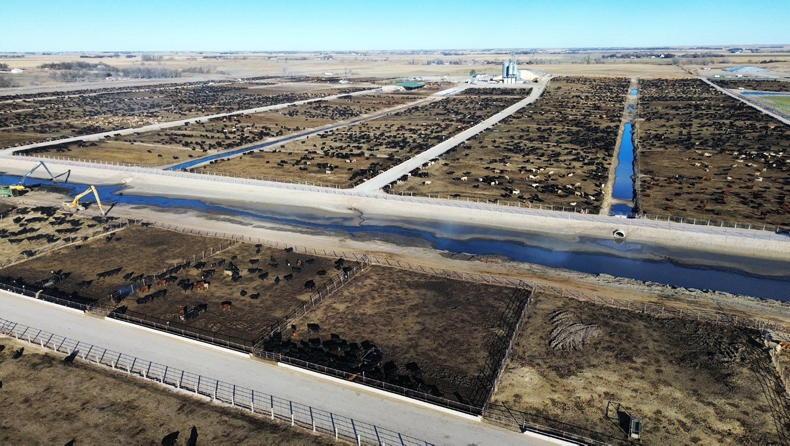

SHARING OPTIONS